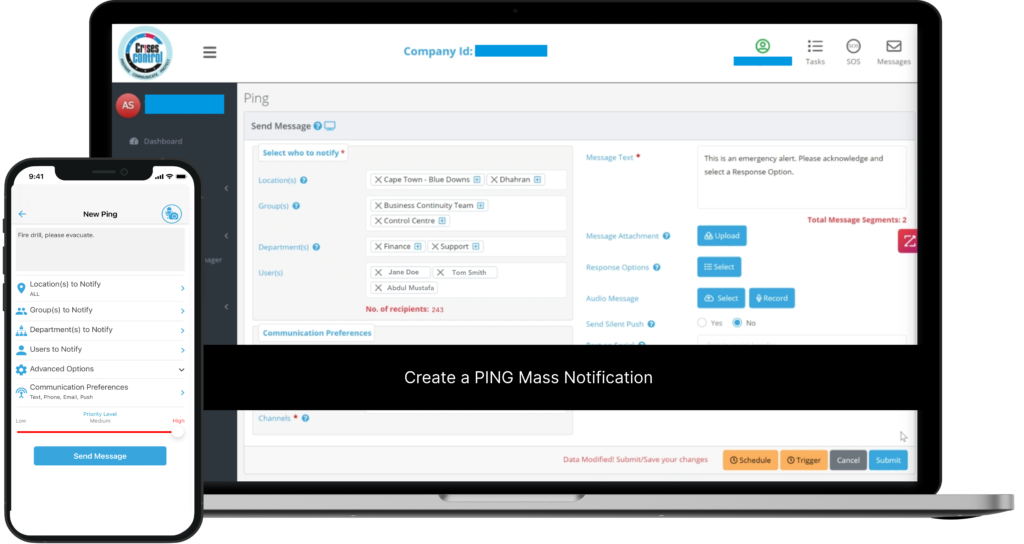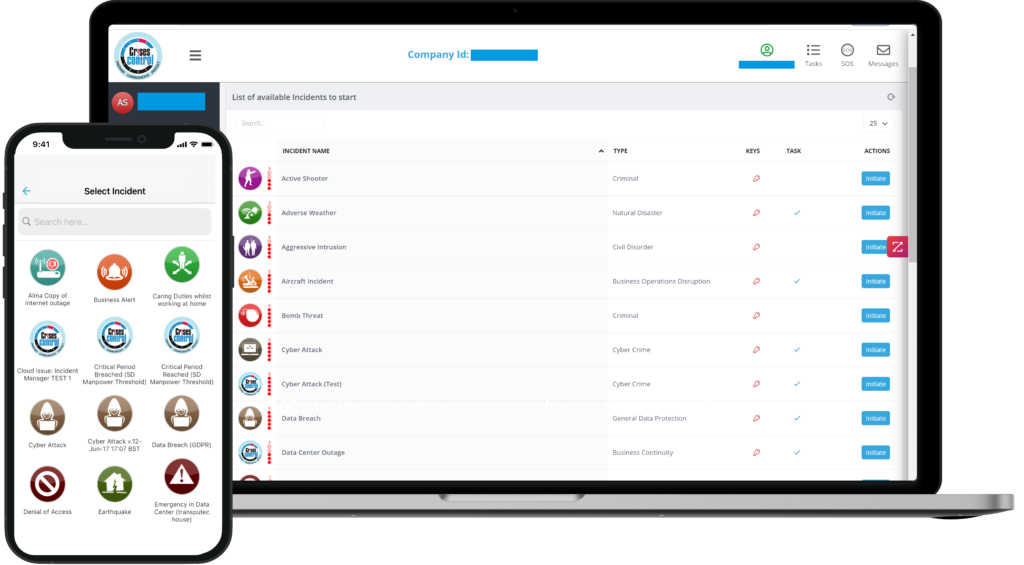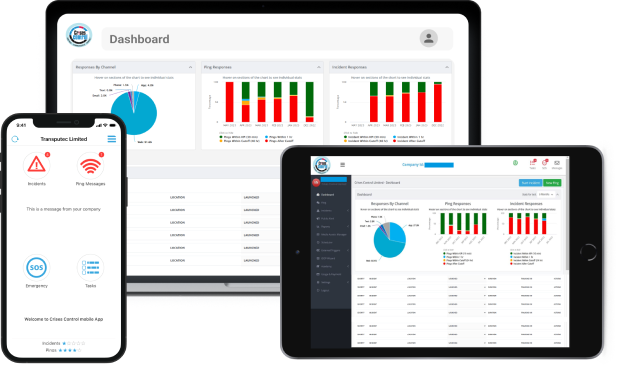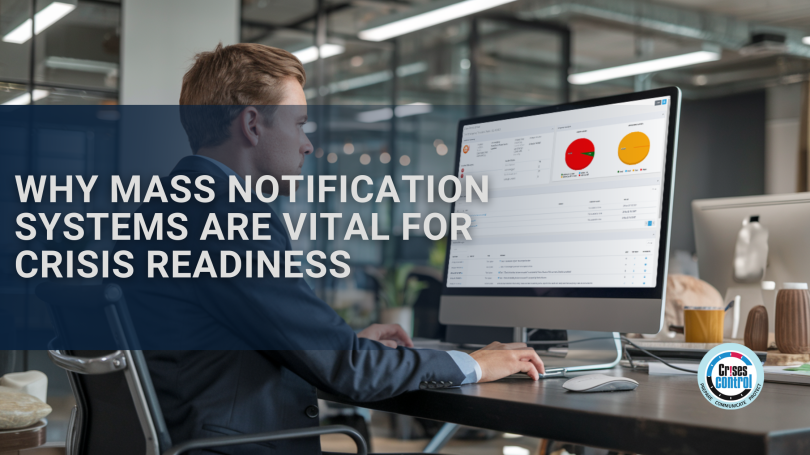Written by Anneri Fourie | Marketing Executive
In a world where emergencies can escalate within seconds, effective communication isn’t just important—it’s vital. From natural disasters to cybersecurity breaches, the speed and clarity with which organisations share critical information can mean the difference between order and chaos. This is why Mass Notification Systems are becoming indispensable for businesses aiming to protect their people, operations, and reputation.
Mass notification systems streamline crisis communication, providing tools that ensure timely, accurate, and actionable information reaches the right people. In this blog, we’ll explore how these systems transform crisis management and communication, tackle common challenges, and discuss how Crises Control offers tailored solutions to keep your organisation resilient in emergencies.
Why Mass Notification Systems Are Critical for Crisis Management
Emergencies come in all shapes and sizes—floods, data breaches, industrial incidents, or even public health emergencies. The one constant in every crisis? The need for clear and immediate communication.
The Problem with Traditional Communication Methods
Before modern solutions, organisations relied on manual processes or single-channel communication, which often fell short during emergencies:
- Delays: Drafting and sending messages manually takes time, especially in high-pressure situations.
- Limited Reach: Relying on one channel (like email) means some people might miss critical updates.
- Confusion: Inconsistent messaging across different groups can create misunderstandings and delays.
Mass notification systems solve these issues by automating and centralising communication, ensuring consistent, multi-channel delivery of critical updates in seconds.
Key Features of Mass Notification Systems for Crisis Management
Mass notification systems are built to address the challenges of modern crisis communication. Here’s how they work:
1. Multi-Channel Communication
A good system ensures messages are delivered via multiple channels: SMS, email, voice calls, mobile apps, and even social media. If one channel fails, another ensures delivery. For example, a fire alarm system might trigger simultaneous text alerts and push notifications, ensuring everyone gets the message.
2. Real-Time Updates
Emergencies evolve quickly, and staying ahead requires constant communication. Mass notification systems allow organisations to send real-time updates as situations unfold, reducing confusion and ensuring everyone knows what to do next.
3. Pre-Configured Templates for Quick Action
During a crisis, every second counts. Pre-configured templates for scenarios like building evacuations, IT outages, or severe weather save time by allowing instant message deployment.
4. Two-Way Communication
Crisis management isn’t just about sending information—it’s also about receiving it. Two-way communication lets employees confirm their safety, report incidents, or ask for assistance. This feedback loop helps organisations make better decisions during critical times.
5. Geo-Targeting for Localised Alerts
Sometimes, a crisis affects only specific locations. Geo-targeting ensures that messages reach the right people based on their location, whether it’s an office building, a factory, or a region hit by extreme weather.
6. Analytics and Post-Crisis Reporting
After the dust settles, organisations need to evaluate their response. Mass notification systems provide analytics and reporting tools to help identify gaps, measure effectiveness, and improve future strategies.
Interested in our Ping Mass Notification System
Efficiently alert everyone in seconds at scale with our Mass Notification System – PING, get the message out fast and ensure rapid response and recovery.

Real-World Scenarios: How Mass Notification Systems Save the Day
1. Natural Disasters
When hurricanes or earthquakes strike, mass notification systems ensure employees receive evacuation instructions, safety updates, or information about relief efforts—all in real-time.
2. Cybersecurity Breaches
A data breach needs swift action. Mass notifications alert employees to secure systems, change passwords, or halt risky activities immediately, containing the damage.
3. Workplace Emergencies
Active shooter situations, fires, or medical incidents require immediate action. Mass notification systems ensure everyone knows how to stay safe or seek help.
4. Multi-Site Operations
For organisations with multiple offices or global operations, consistent communication is a challenge. Mass notification systems ensure that messaging is uniform, whether it’s a weather warning in one region or a system outage affecting several sites.
The Crises Control Difference: A Tailored Solution for Every Emergency
At Crises Control, we understand that no two organisations face the same challenges. Our Mass Notification System is designed to provide flexibility, reliability, and speed, ensuring your crisis communication strategy is always a step ahead.
1. Ping Mass Notification
Our Ping Mass Notification feature ensures instant delivery of messages through multiple channels, reducing delays and ensuring everyone gets the message.
2. Integration with Incident Management
Crises Control’s Ping Mass Notification feature integrates seamlessly with our Incident Manager module, allowing you to coordinate your response while maintaining clear communication.
3. Customisable Alert Templates
Time-saving templates let you prepare for specific scenarios in advance, from IT outages to evacuation protocols.
4. Cloud-Based Reliability
Unlike systems reliant on third-party infrastructure, Crises Control operates on its own secure cloud. Even if a major IT provider experiences downtime, our mobile app ensures uninterrupted service.
5. SOS Panic Button
The SOS Panic Button empowers employees to report emergencies instantly, and get immediate help if needed.
6. Real-Time Analytics
Our robust reporting tools give you actionable insights after every crisis, helping you refine your processes and close any gaps in your strategy.

Interested in our Incident Management Software?
Customise your Crisis Incident Management Software to meet your specific needs with our flexible tools & stay connected and informed during the crisis and incident management process
Transforming Crisis Communication: Benefits You Can Count On
With Crises Control’s Mass Notification System, your organisation gains:
- Faster Crisis Response: Automate communication and focus on managing the crisis.
- Enhanced Safety: Protect employees, customers, and assets with timely, actionable updates.
- Improved Business Continuity: Minimise downtime and maintain operations.
- Regulatory Compliance: Meet legal requirements for emergency communication.
- Scalability: A solution that grows with your business, from small teams to global enterprises.
Conclusion: Stay Prepared, Stay Resilient
Effective crisis management begins with clear and reliable communication. Mass notification systems ensure that your organisation can respond quickly, protect its people, and maintain continuity in even the most challenging circumstances.
With Crises Control, you’re not just adopting a tool—you’re building a robust crisis communication strategy. Our advanced mass notification features, tailored solutions, and reliable cloud infrastructure give you the peace of mind you need to face any situation.
Don’t wait until it’s too late. Take the first step towards better crisis communication today. Contact us to book a free demo and see how Crises Control can transform your organisation’s crisis readiness.
Request a FREE Demo

